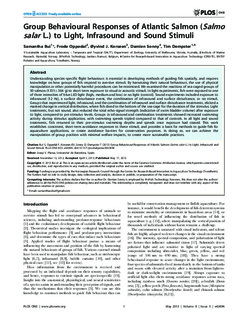| dc.description.abstract | Understanding species-specific flight behaviours is essential in developing methods of guiding fish spatially, and requires knowledge on how groups of fish respond to aversive stimuli. By harnessing their natural behaviours, the use of physical manipulation or other potentially harmful procedures can be minimised. We examined the reactions of sea-caged groups of 50 salmon (1331±364 g) to short-term exposure to visual or acoustic stimuli. In light experiments, fish were exposed to one of three intensities of blue LED light (high, medium and low) or no light (control). Sound experiments included exposure to infrasound (12 Hz), a surface disturbance event, the combination of infrasound and surface disturbance, or no stimuli. Groups that experienced light, infrasound, and the combination of infrasound and surface disturbance treatments, elicited a marked change in vertical distribution, where fish dived to the bottom of the sea-cage for the duration of the stimulus. Light treatments, but not sound, also reduced the total echo-signal strength (indicative of swim bladder volume) after exposure to light, compared to pre-stimulus levels. Groups in infrasound and combination treatments showed increased swimming activity during stimulus application, with swimming speeds tripled compared to that of controls. In all light and sound treatments, fish returned to their pre-stimulus swimming depths and speeds once exposure had ceased. This work establishes consistent, short-term avoidance responses to these stimuli, and provides a basis for methods to guide fish for aquaculture applications, or create avoidance barriers for conservation purposes. In doing so, we can achieve the manipulation of group position with minimal welfare impacts, to create more sustainable practices. | no_NO |
